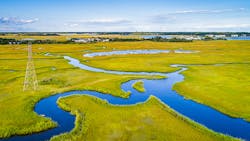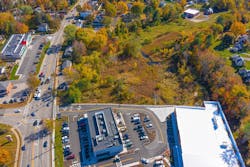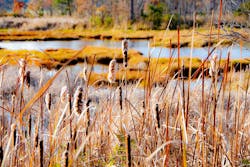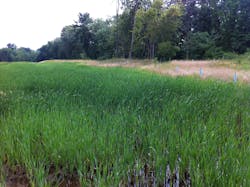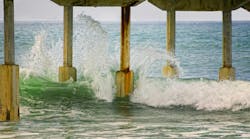As we shelter in place, some of us are learning new tricks in the kitchen—ever caught sourdough starter from the air? Others are dusting off that old guitar or taking up a new hobby. Making the most of what we have is an important lesson from quarantine, and it applies as much to stormwater management as it does to life at home.
A common reaction to new regulations is to focus on the perceived cost of having to do something differently. The science behind a stormwater permit is challenged, the feasibility of compliance is questioned as communities consider piling more work on already stretched staff, and often, lawyers are hired. This almost always leads to more costs and divisive politics, but it doesn’t always lead to a solution or even an appreciably different outcome.
Instead, what if we focused on what was possible using the resources at hand? What if we could redefine the value of ongoing work so it could receive appropriate regulatory credit where it had not before? Those were the questions driving a New Hampshire–based effort to develop performance curves that could be used to assign regulatory credit for restored or constructed buffers as water quality best management practices (BMPs). Developed in response to community need, these curves have not only been accepted by regulatory agencies, the expert panel process that created them is being explored for other BMPs in New Hampshire and the region.
Where’s the Credit?
Any time a new stormwater permit rolls out, there are two sides to the equation—the regulatory target and the credit a community receives for the actions they take to meet it. The regulatory side can bring with it a sense of failure. Because of past action, or lack of action, communities must now work toward what can feel like an artificial goal. While we have yet to meet anyone who argues explicitly for dirty water, it is difficult to boil down the concept of “swimmable, fishable, and drinkable” to a pollutant load reduction. Yet, around the country, millions of dollars are spent doing just that. Courts often litigate what is feasible rather than what is practical, but this distinction is seldom determined in a courtroom—more often it is settled by municipal staff, working in the field with the skills and budgets they have on hand.
It can be just as productive to consider whether available science will support enhanced regulatory credit for activities that are already happening—for example, street sweeping—or for nonstructural BMPs like buffers. Using this science has its challenges, not the least of which is a pervasive distrust of any research that is not conducted in a community’s “backyard.” Even if local science does exist, decision-makers may not be aware of it or understand its relevance to their work. As a result, practitioners and permittees have to draw a circle around a “universe” of tools that have established methods of calculating pollutant load reduction, regardless of whether existing science would support the use of other BMPs.
In 2018, this was the case for Dover and other cities and towns in New Hampshire’s Great Bay watershed when it came to the subject of buffers. These areas of natural land around wetlands and water bodies were highly valued for their ability to keep water clean, provide habitat, control erosion, and reduce flooding. There also was a robust body of local science and data to support a healthy buffer’s capacity to provide these benefits. However, communities found it difficult to quantify these values and therefore receive credit for the use of buffers under the state’s stormwater permit. They clearly wanted to “go green,” but they reasonably asked, “Where’s the credit?”
These communities weren’t the first to do so (and they won’t be the last). Stormwater scientists, regulators, and circuit riders on the Chesapeake Bay had faced similar questions more than a decade ago, and the expert panel–based approach they spun up to credit green infrastructure has been a game-changer for the region. That success inspired a team led by the University of New Hampshire Stormwater Center, the Great Bay National Estuarine Research Reserve, and Roca Communications to test whether this approach could be used to help New Hampshire’s communities get the credit they were looking for.
Today they can, at least for buffers that have been constructed or restored as part of a development or redevelopment project. This was not the holy grail that our team or New Hampshire communities were looking for—we hoped to support credit for natural, existing buffers—but the process of getting here has helped stakeholders on both sides of the permitting equation understand that the real value may have been in the journey, not the destination. The expert panel process of interpreting and applying the science related to buffers could just be the key to unlocking credit for a range of nonstructural BMPs that are already active components of the region’s municipal stormwater programs.
Do it FASTIt’s a given that New Hampshire’s Great Bay is not the Chesapeake. It’s much smaller, the soils are not the same, there’s less agriculture, and who wouldn’t take lobster over crab? Likewise, the Chesapeake’s regulatory jurisdiction is vastly different, involving seven states and a TMDL, which does not exist for the Great Bay. As a result, not everything about the Chesapeake’s process made the journey north. For example, we augmented their literature review to include relevant science from our region. Lacking a TMDL, we engaged regulators early to ensure the pollutant reduction performance curves would pass muster under the state’s new stormwater permit.
Ultimately, through experimentation with their process and documentation of our own experience, we developed a modified approach, one we call “FAST” (Yes, it took a year and a half, but we all know in “stormwater years,” that’s only about four months). FAST is an iterative, weight-of-evidence approach in which a panel of experts can reach a general agreement, though not necessarily unanimity, around science-based recommendations for resource management. It’s flexible enough to be applied with different levels of rigor, depending on the situation at hand. Essentially, FAST is for problems in want of science-based solutions, in places where intensive, site-specific research is beyond reach and existing data and science are insufficient. It involves four integrated steps:
- Frame Your Question: Our team built on everything we knew about community interests related to buffers to frame a question for our expert panel. This included a recent analysis of buffer policy, science, and community perspectives and an effort to track nonpoint source pollution at the regional scale (Buffer; NHDES and UNHSC). During this phase and throughout, Tom Schueler, executive director of the Chesapeake Stormwater Network, provided invaluable mentorship, helping us build local confidence in the approach and negotiate unexpected turns in the panel’s deliberations. An important piece of advice he shared was to secure sufficient resources and the right expertise to truly support the panel from a technical and process perspective. A transfer grant from the NOAA-sponsored National Estuarine Research Reserve System (NERRS) Science Collaborative, which is dedicated to sharing place-based science, made this possible.
- Assemble the Team: Our project was driven by a core team that refined the concept and recruited the advisory committee and expert panel. The committee included municipal representatives, regulators, technical assistance providers, and stormwater engineers. As a sounding board for the project, they suggested panelists, provided input on the literature review, and shared ideas on how to communicate results. Our panel included regulators, watershed hydrologists, a fish and wildlife biologist, a geologist, and a former stormwater engineering consultant. Their role was to enrich the literature review, refine the meaning of buffers for this application, and make many other critical decisions that led to science-based recommendations for assigning regulatory credit. We found that having panelists who understood the management needs behind the question and worked well with others was as important as having the right mix of expertise.
- Sustain Momentum: Despite its name, FAST can feel more like a marathon than a sprint. Our project took three months longer than anticipated, in part due to the complexity of the science and the regulatory framework surrounding a buffer’s ability to mitigate nonpoint source pollution. The many physical factors that influence buffer performance are interdependent, and it was difficult to decide which to address and in what order. Shepherding the panel toward its goal required patience, persistence, flexibility, and above all, preparation. Together with our advisors and panelists, we agreed on how we would work, make decisions, and communicate throughout the process. We gave panelists real work to do during meetings, and we used the time in between as an opportunity to encourage reflection on past decisions, assumptions, and sticking points.
- Take It on the Road: In the final phase, we worked with the panel to synthesize their recommendations in a technical memorandum and a comprehensive final report. We vetted these with the advisory committee and solicited their input on how best to package and share them with municipalities, consultants, and others who would need to be aware of, or use the recommendations. They helped us develop an outreach plan, messages, and communications products that everyone—our core team, panelists, and the advisory committee members can use to share the results of this project and the FAST process throughout their professional networks.
As we move from quarantine into the new normal, every sector is re-examining “business as usual.” In the stormwater field, we must do the same. It’s time to reimagine our approach to reducing the pollution that is flowing into our water bodies.
A good place to start is by taking a fresh look at our toolbox to see if it can be expanded. Can we make science-based improvements to routine operations like catch basin cleaning, street sweeping, or leaf collection? Are there affordable BMPs we could adopt? An expert panel process like FAST can help quantify the water quality value of these improvements to ensure we are getting the maximum credit deserved as we strive to make our rivers, lakes, and streams swimmable, fishable, and drinkable.
In some ways the math is the easy part; the hard part is building more effective and affordable stormwater programs. But it’s worth it—when we make small changes with big impacts, we are doing much more than meeting a TMDL. BMPs that rely on infiltration and filtration will not stop sea-level rise, but they do position communities to be more resilient to flooding. Natural infrastructure like buffers help protect water quality while contributing to the green space that everyone knows is vital to public health. If quarantine has taught us anything, it’s to make the most of what we have.
References
Buffer Options for the Bay. www.bufferoptionsnh.org.
City of Dover, New Hampshire. "Stormwater in Dover. www.dover.nh.gov/government/city-operations/planning/stormwater/index.html
Great Bay National Estuarine Research Reserve, Roca Communications, and University of New Hampshire Stormwater Center. “FAST: Expert Panel Process for Decision Making.” www.bit.ly/2CBqQMd
–––Pollutant Removal Credits for Restored or Constructed Buffers in MS4 Permits. “Technical Memorandum.” www.bit.ly/3h5hIyA
–––Pollutant Removal Credits for Restored or Constructed Buffers in MS4 Permits. “Final Report.” www.bit.ly/3l4JFJg
New Hampshire Department of Environmental Services and UNH Stormwater Center. “New Hampshire Department of Environmental Services Pollutant Tracking and Accounting Pilot Project.” www.unh.edu/unhsc/ptapp.
UNH Stormwater Center. “Berry Brook Project.” University of New Hampshire, January 9, 2018. www.unh.edu/unhsc/berry-brook-project.
